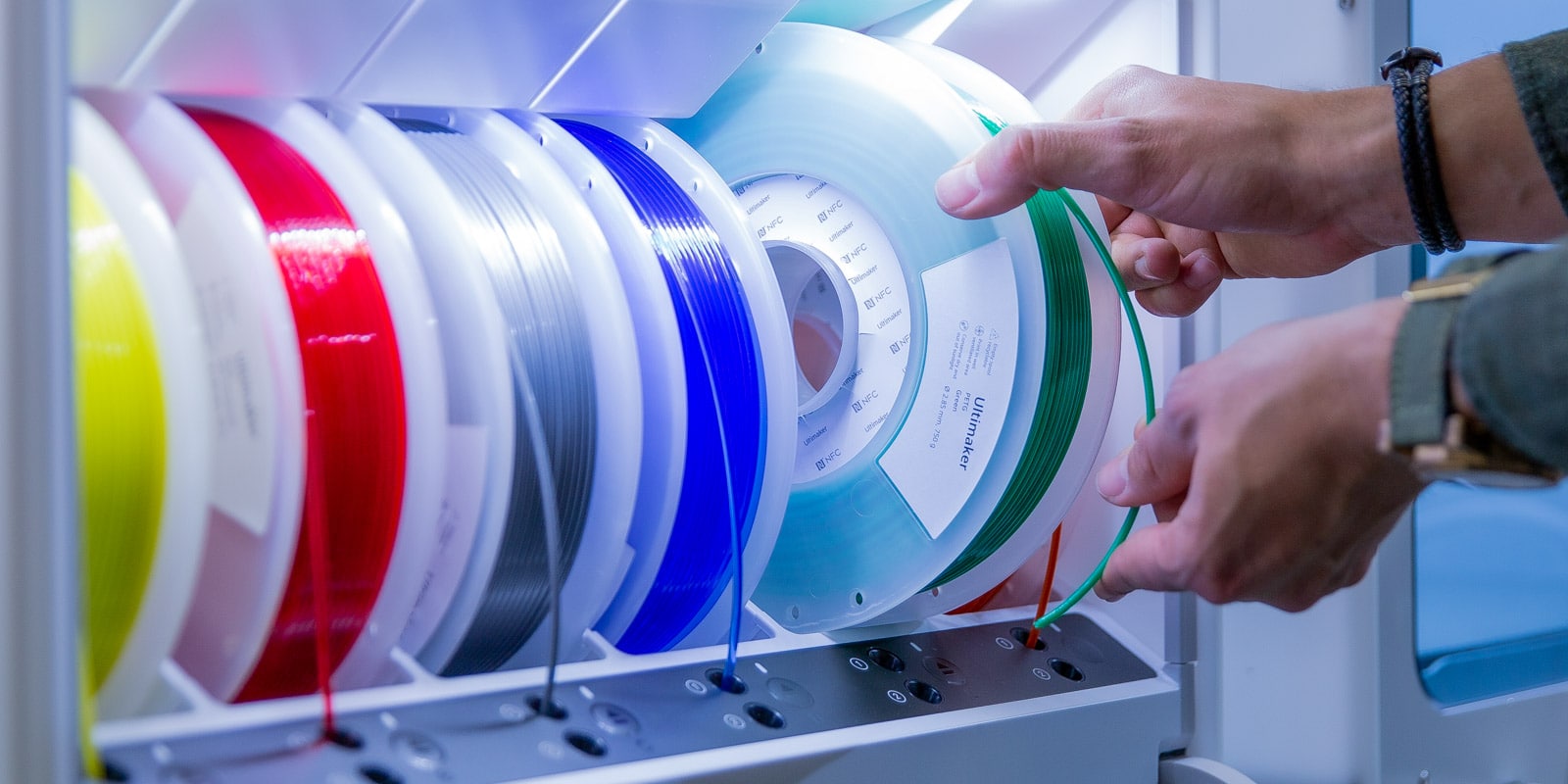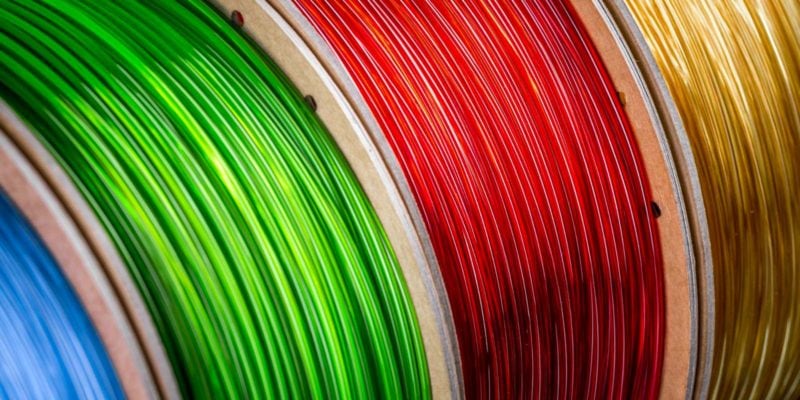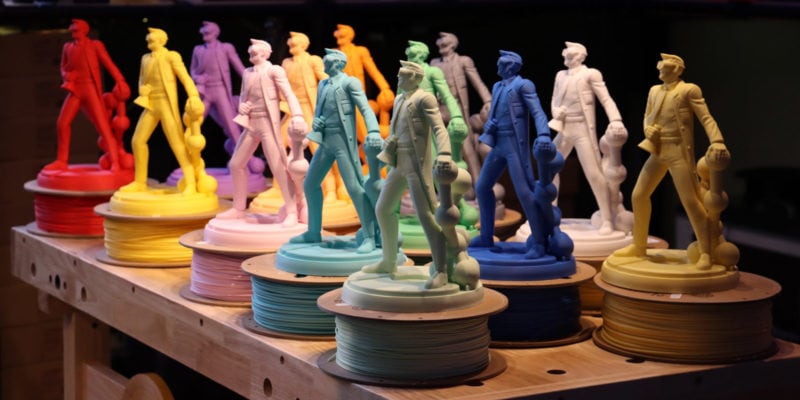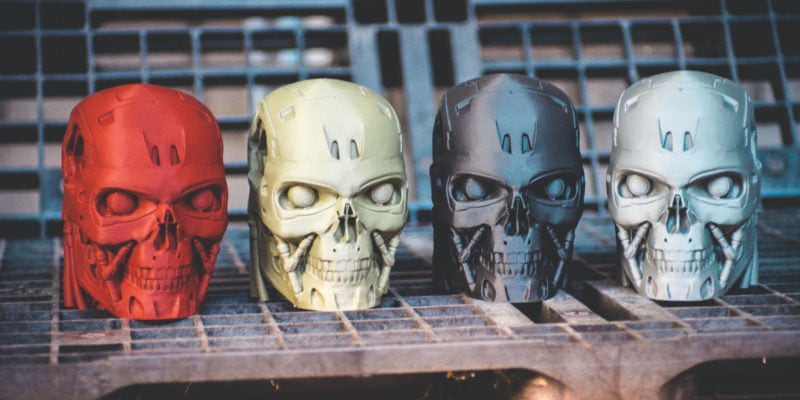Are you interested in 3D printing with PETG filament but you don’t know what to look for? This is an understandable concern since there are so many brands and varieties of PETG on the market to choose from. But don’t worry! We can help you find the best PETG filament to suit your needs.
In this article, we’re going to give you a few tips on what to look for when buying PETG filament. We’ll also recommend our favorite brands and products.
| Best PETG Filament | # of Colors | Accuracy | Diameters | Price/kg | Best Offer |
|---|---|---|---|---|---|
| Polymaker PolyLite PETG | 12 | N/A | 1.75mm, 2.85mm | $22 | |
| Prusament PETG | 20 | +/- 0.02mm | 1.75mm | $30 | |
| Overture PETG | 16 | +/- 0.03mm | 1.75mm | $23 | |
| eSUN PETG | 16 | +/- 0.03mm | 1.75mm, 2.85mm | $22 | |
| Hatchbox PETG | 26 | +/- 0.03mm | 1.75mm | $24 | |
| SUNLU PETG | 7 | +/- 0.02mm | 1.75mm | $20 | |
| Duramic PETG | 14 | +/- 0.05mm | 1.75mm | $20 | |
| Priline Carbon Fiber PETG | 1 | +/-0.03mm | 1.75mm | $49 | |
| Colorfabb Economy PETG | 6 | +/- 0.10mm | 1.75mm, 2.85mm | $55 | |
| Ultimaker PETG | 14 | +/- 0.05mm | 2.85mm | $67 | |
| Amazon Basics PETG | 10 | N/A | 1.75mm | $22 |
What is PETG Filament?
PETG (Polyethylene Terephthalate Glycol) is a popular thermoplastic used in 3D printing. PET plastics are most commonly used in beverage and food packaging. The glycol (G) is added to the material to make it less brittle for 3D printing.
What are the Benefits of PETG Filament?
PETG has several benefits over other types of filaments, including:
- PETG is strong and durable. It can withstand a lot of wear and tear, making it ideal for use in 3D printed products that will see a lot of use.
- It is easy to print with. It doesn’t require a heated bed and can be printed at lower temperatures than ABS, making it less likely to warp or shrink during the printing process.
- PETG filament produces little to no 3D printer fumes, making it a safer option for those with asthma or other respiratory conditions.
- It is food-safe, making it ideal for use in 3D printed kitchen products or food containers.
- PETG filaments are typically less expensive than other types of filaments, making them a more budget-friendly option for 3D printing.
Overall, PETG 3D printing filament is a versatile and user-friendly option for 3D printing. It’s strong and durable, easy to print with, and has high UV and chemical resistance, making it the best filament choice for a wide variety of applications.
The Best PETG Filament Brands in 2024
Polymaker PolyLite PETG is a high quality PETG filament that offers users a smooth printing experience. It has a reasonable price, glossy finish, and excellent durability to ensure high-quality 3D prints.
Since Polymaker uses the Pantone system for their color shades, they are excellent for color-matching. Not only will you know exactly what shade to expect when buying (which can be a challenge when buying online), it also means better color consistency between filament batches.
Polymaker PETG has a fairly low extrusion temperature for a PETG filament at 235°C, making it possible to print it without an all-metal hot end.
Polymaker also makes the PolyMax line of PETG 3D printer filament. The PolyMax filaments can be used with the same print settings as PolyLite, but it has greater strength and impact resistance. It only has two colors available, however, so it is not a suitable replacement for PolyLite. However, for 3D printing PETG parts that undergo more mechanical stress, PolyMax is the superior material
If you’re looking for the best PETG filament, PolyLite PETG is the obvious choice. Whether you’re looking to create functional parts or simply print stunning visuals, it is up to the task. And because it’s so easy to use, you’ll be able to get great results regardless of your experience level.
Technical Details |
|
|---|---|
| Nozzle Temperature | 230°C - 240°C |
| Bed Temperature | 70°C - 80°C |
| Diameter | 1.75mm, 2.85mm |
| Number of Colors | 12 |
| Spool Sizes | 1kg |
| Dimensional Accuracy | Not disclosed |
Prusament is a premium filament brand with a line of PETG filaments that are made with high-quality materials and equipment. Their products have high dimensional accuracy, impressive layer adhesion, and low shrinkage. They also have excellent quality control and include a QR code on each spool that allows you to view the technical data of your specific batch of filament.
At +/- 0.02mm diameter accuracy, Prusament is some of the best PETG 3D printer filament that ensures smooth feeding of the material. To reduce PETG stringing, Prusa offers preset slicer settings to be used with their Prusa line of printers.
Prusament PETG has a high print temperature, so this isn’t suitable for budget 3D printers that don’t come with an all-metal hot end. With that said, if you do have an all-metal hot end, Prusament PETG is a great option for producing high-quality prints.
Technical Details |
|
|---|---|
| Nozzle Temperature | 250°C |
| Bed Temperature | 70°C - 90°C |
| Diameter | 1.75mm |
| Number of Colors | 12 |
| Spool Sizes | 1kg |
| Dimensional Accuracy | +/- 0.02mm |
Despite producing affordable filament, Overture is a brand that excels at making quality control a top priority. They use full mechanical winding to ensure tangle-free 3D printing, so you won’t run into tensile issues with their spools. And since Overture PETG tends to be clog and bubble-free, the printing process is consistent with few (if any) extrusion issues.
Overture PETG also doesn’t produce many fumes while printing, making it one of the best PETG filaments for use inside your home. It also has great liquidity, which makes it easy to print with and gives finished parts a nice glossy shine.
Overture dries their filaments for a full 24 hours to ensure that no water contaminates them. They also come vacuum sealed in resealable aluminum bags over the usual plastic and nylon choices for better protection against humidity. Their dimensional accuracy of +/- 0.03mm is more than acceptable, thanks to the advanced CCD diameter measuring their products undergo before winding.
All in all, Overture PETG filament is a great choice for anyone looking for quality filament without breaking the bank. You can be sure that every spool will produce high-quality prints, time and time again.
Technical Details |
|
|---|---|
| Nozzle Temperature | 230°C - 250°C |
| Bed Temperature | 80°C - 90°C |
| Diameter | 1.75mm |
| Number of Colors | 16 |
| Spool Sizes | 1kg |
| Dimensional Accuracy | +/- 0.03mm |
An affordable 3D printer filament with a wide assortment of colors, eSun PETG is a high strength, low stringing option. It has a higher printing temperature than most PETG filaments with a recommended extruder temperature of 250°C – 280°C. That makes this a filament that you likely cannot print without an all-metal hot end in your 3D printer without potentially damaging your extruder.
While a higher printing temperature usually means higher heat resistance, this is not the case with eSUN PETG filament. It has a glass transition temperature of about 60°C, which is lower than the average for PETG. Most filament brands (including colder printing ones) usually soften around 80°C – 85°C, so eSUN has temperature properties closer to PLA than to PETG.
Even with the limited temperature endurance, eSUN PETG filaments are durable and easy to use. They are designed to be low stringing and clog-free, and they are packaged to ensure no tangling or moisture issues ruin your print quality.
If you have been unhappy with other PETG filaments, give eSun’s a try – they may just be the best 3D printer filament for your needs.
Technical Details |
|
|---|---|
| Nozzle Temperature | 235°C - 250°C |
| Bed Temperature | 60°C - 80°C |
| Diameter | 1.75mm, 2.85mm |
| Number of Colors | 16 |
| Spool Sizes | 1kg, 3kg |
| Dimensional Accuracy | +/-0.03mm |
A solid all-purpose brand, Hatchbox PETG filament has a low price point, huge assortment of color options, and good dimensional accuracy.
If you’re looking for a brand that has practically every shade you can think of, Hatchbox is always a safe bet. Their line of PETG filaments is no exception. Not only do they offer an excellent variety of opaque and transparent filament, but they also have specialty PETG options like glitter and glow in the dark.
Another hallmark of PETG filament that Hatchbox improves upon is its excellent layer adhesion. You should have little to no issues getting this filament to stick to most surfaces even without a heated build plate.
Hatchbox offers great value and a wide range of colors that are sure to please even the most discerning users. With good layer adhesion and few filament jams, this brand is hard to beat.
Technical Details |
|
|---|---|
| Nozzle Temperature | 230°C - 260°C |
| Bed Temperature | Not required |
| Diameter | 1.75mm |
| Number of Colors | 26 |
| Spool Sizes | 1kg |
| Dimensional Accuracy | +/- 0.03mm |
Not only is SUNLU PETG filament one of the most affordable on our list of best PETG filaments, but it also offers good printability. It boasts a clog and bubble-free printing process and based on reviews, its users seem to confirm this.
At 200°C – 220°C, it has the lowest extrusion temperatures of any of the other PETG filaments on this list. This makes it perfect for users looking for an easy PLA and ABS filament alternative. Its low print temperature range means you can easily try 3D printing with SUNLU PETG filament with budget 3D printers without fear of melting the PTFE tubing in the hot end.
This brand also doesn’t need a heated bed, making it one of the most compatible PETGs on the list. With the printing properties it has, it can be printed on 3D printers that do not have the right compatibility to print other PETG filaments.
Technical Details |
|
|---|---|
| Nozzle Temperature | 200°C - 220°C |
| Bed Temperature | Not required |
| Diameter | 1.75mm |
| Number of Colors | 7 |
| Spool Sizes | 1kg |
| Dimensional Accuracy | +/- 0.02mm |
Duramic PETG 3D printer filament offers smooth extrusion at an affordable price. Clog, bubble, and tangle-free, Duramic is one of the best PETG filaments for smooth printing. It also has minimal warping and stringing issues, with great layer adhesion and strong first layers.
Their dimensional accuracy is not as precise as most of the other filaments on the list at +/- 0.05mm. However, since that is the industry standard, it will still produce even extrusions and good print quality.
It comes in a vacuum-sealed aluminum resealable bag with desiccant to better keep out moisture and to have a convenient place to store opened 3D printing filament between uses. Its nozzle temperatures are out of the range of what most regular hot ends can handle, so this is a product that works best with an all-metal hot end.
Technical Details |
|
|---|---|
| Nozzle Temperature | 240°C - 250°C |
| Bed Temperature | 70°C - 80°C |
| Diameter | 1.75mm |
| Number of Colors | 14 |
| Spool Sizes | 1kg |
| Dimensional Accuracy | +/- 0.05mm |
With excellent layer and bed adhesion, little to no warping or shrinkage, and high dimensional accuracy, Priline Carbon Fiber PETG takes some of the stress out of printing carbon fiber. It has the ease of use of PETG without the typical hassles of carbon fiber filament.
Priline Carbon Fiber PETG produces incredibly durable prints with a high tensile modulus. While its printing temperature ranges are a bit higher than some of the other PETG filament options, it isn’t a significant difference.
Priline does warn that this PETG works best with an enclosure. So using an enclosed 3D printer (or adding a DIY 3D printer enclosure yourself) will give you the best results. Despite that, you can also use it in an open-frame printer with decent results.
This 3D printer filament is perfect for applications that need added strength and stiffness, including automotive parts, drones, and mechanical assemblies.
Technical Details |
|
|---|---|
| Nozzle Temperature | 240°C - 260°C |
| Bed Temperature | 100°C |
| Diameter | 1.75 |
| Number of Colors | 1 |
| Spool Sizes | 1kg |
| Dimensional Accuracy | +/- 0.03mm |

Colorfabb’s economy line of PETG filament is perfect for users who need large spools of material at a reasonable price. Bigger prints on large 3D printers would benefit from the 4.5kg and 8kg spools, since you don’t need to swap out filament spools mid-print.
Their color options on Colorfabb Economy PETG are rather limited to the basics. The softening point is also lower than the average PETG filament range at 70°C, making this a less suitable option for projects that need to stay in environments with high temperatures.
Its dimensional accuracy is also not exceptional, so we only recommend this PETG 3D printing filament as an affordable filament for users with a large 3D printer.
Technical Details |
|
|---|---|
| Nozzle Temperature | 235°C - 255°C |
| Bed Temperature | 70°C - 80°C |
| Diameter | 1.75, 2.85mm |
| Number of Colors | 6 |
| Spool Sizes | 750g, 2.2kg, 4.5kg, 8kg |
| Dimensional Accuracy | +/- 0.10mm |
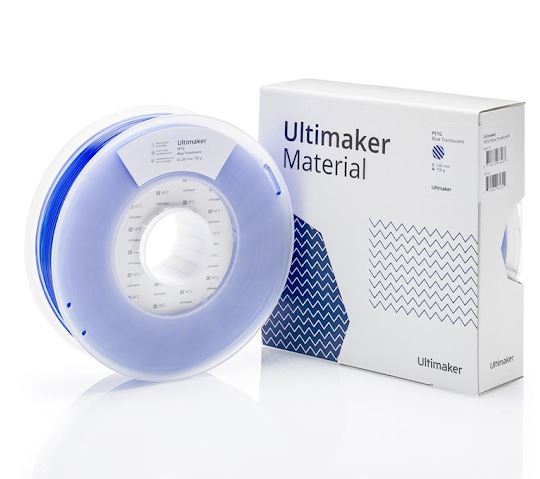
Made specifically for use with the Ultimaker printers, Ultimaker PETG filament only comes in the 2.85mm diameter. That greatly limits the amount of 3D printers this material is compatible with. Its higher nozzle temperature requirement limits its compatibility even further.
This product is the stock filament Ultimaker printers are built to work with. If you have an Ultimaker, using the on-brand filament means you don’t have to play around much with printer settings before you get started since it is already calibrated to this product perfectly.
Ultimaker PETG also works well with the Ultimaker brand support materials, so if you have prints that require a lot of support during 3D printing, using this paired with the on-brand supports could be extremely time-saving.
Overall, Ultimaker PETG is mostly a 3D printing filament to use with an Ultimaker 3D printer. If you are looking for a hassle-free PETG filament for your Ultimaker that will produce high-quality prints time and time again, this is the product for you.
Technical Details |
|
|---|---|
| Nozzle Temperature | 250°C - 260°C |
| Bed Temperature | 65°C - 70°C |
| Diameter | 2.85mm |
| Number of Colors | 14 |
| Spool Sizes | 750g |
| Dimensional Accuracy | +/- 0.05mm |
Considered another budget option, Amazon Basics PETG filament does what it says in its name and sticks to the basics. It focuses on reducing jams for a smooth printing experience and keeping its high-quality glossy finish through the printing process. It is one of the best PETG filament options for users looking for a versatile and affordable brand.
Their PETG filament uses an average nozzle temperature range of 230°C to 250°C. While it likely works with cheaper extruders, it is best to use it with an all-metal hot end in case it needs to reach the upper limits of its temperature range.
With 10 different colors available, it has a decent variety of options. It doesn’t list its dimensional accuracy ranges, but user reviews don’t mention consistent issues with the diameter accuracy, so it is likely within the average +/-0.05mm range.
This is a good all-around filament, but it doesn’t have any outstanding features that make it stand out from the crowd. If you are looking for a versatile and affordable option, this is a great choice.
Technical Details |
|
|---|---|
| Nozzle Temperature | 230°C - 250°C |
| Bed Temperature | 80°C - 90°C |
| Diameter | 1.75mm |
| Number of Colors | 10 |
| Spool Sizes | 1kg |
| Dimensional Accuracy | Not Disclosed |
Buyer’s Guide: What to Look for When Buying PETG Filament
Diameter
The first thing to ensure when buying PETG filament is that the brand comes in the correct diameter for your printer. Most 3D printers work with a 1.75mm filament size, so it is the most common diameter you will encounter while shopping for 3D printer filament. Some brands, like Ultimaker PETG filament, come in a diameter of 2.85mm.
You should also consider the spool diameter. If you have a 3D printer that holds the filament inside the printer, you will need to make sure the spool fits your printer’s compartment. Otherwise, you will need to use an external spool holder.
Stringing Tendency
Even the best PETG filament tends to print a little stringy in comparison to other 3D printer filament materials. The biggest factor in preventing PETG stringing is to find the right print settings for your specific 3D printer and the PETG filament brand you’re using. However, there are also a few considerations to take into account when buying PETG that can minimize stringing.
A high-quality PETG filament usually gives less stringing than cheaper alternatives. That’s because they use quality raw materials in their products, making them less likely to have extrusion inconsistencies. Duramic and eSUN filaments are two good options for PETG filaments that give less stringing than other brands.
Color Consistency
One of the biggest issues with PETG 3D printing filament is its resistance to certain outside compounds. This gives problems when painting and gluing 3D prints, but it also comes into play with the coloring pigments in the PETG itself.
This means that when producing PETG filament, creating consistent colors can be difficult. You may find that a certain color may be a different shade from one spool to another or even fluctuate within a single spool.
This can cause problems if you are printing a large object that requires more than one spool to finish. Without consistent colors, you may end up with a visible seam where one spool ends and another spool starts. Likewise, if you sell your 3D prints to make money with your 3D printer, keeping a consistent shade between your prints is desirable for quality control and meeting customer expectations.
Polymaker PETG is the best PETG filament for color consistency because they use the Pantone Matching System for their filament colors. The Pantone System is a color identification and matching system used by traditional printers and designers to correctly match shades between design and finished product.
Dimensional Accuracy
Good dimensional accuracy in PETG 3D printer filament is essential for getting great quality prints. Dimensional accuracy (also sometimes known as diameter accuracy) refers to how much the diameter will fluctuate in size from the advertised diameter. A 1.75mm filament with a dimensional accuracy of +/- 0.03mm will have points throughout the spool in which the filament is up to 1.78mm or down to 1.72mm in diameter.
A smaller dimensional accuracy means better printing results because it means less variance in the size of the filament. Significant changes in the size of your filament can lead to uneven extrusion, gaps, blogging, holes, and even 3D printer jams since the extruder is either sending in more or less material than it thinks it is.
Spool Winding
Proper spool winding is another major factor in buying the right filament. Quality filaments ensure their spools are wound at a consistent tension to avoid tangling and breakage. If a spool does get tangled, it can cause too much tension to the spool feeding to the printer, resulting in under extrusion, filament breakage, and extruder jams.
Material Purity
High-quality filaments use high-grade raw materials to ensure their products keep printing smooth. Low-quality materials containing contaminants, fillers, and additives can behave in unexpected ways, leading to inconsistent quality. The best PETG filament brands are transparent about the materials in their products.
Packaging
Quality packaging is an important factor that keeps PETG filament working well. Most PETG brands are hygroscopic, meaning they absorb water from their surrounding environment. A high-quality vacuum-sealed bag with desiccant is a must for keeping the humidity from the air out of the filament.
Good PETG 3D printer filament brands will also dry the spools before they vacuum seal them, to ensure their PETG filament stays clog, stringing, and bubble-free during the printing process.
For the best long-term results, it is important to store your PETG 3D printer filament in a filament dry box. This prevents the filament from absorbing too much moisture.
What is PETG Filament Best for?
PETG 3D printing filament works well for making industrial parts, outdoor prints, and any other parts that will be under mechanical or impact stress. It’s also great for projects that need chemical, UV, or solvent resistance.
Is PETG Really Stronger Than PLA?
Both PLA filament and PETG filaments have high tensile strength and score around 7000 psi when tested. However, PETG does tend to score slightly higher. PLA is also brittle and tends to shatter on impact, whereas PETG is softer and more flexible than PLA, giving it better impact resistance. PETG is also stronger against chemicals and solvents than PLA is.
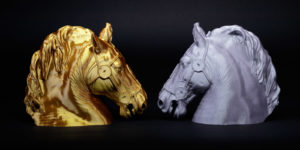
Can the Ender 3 Print PETG?
Yes, you can print PETG in the stock configuration without Ender 3 upgrades. The Ender 3 has a maximum extruder temperature of 240°C and a heated bed, making it capable of printing PETG. The hot end can technically reach higher temperatures, but that risks melting the extruder’s PTFE tubing. Since some brands have an upward temperature range of 250°C, it is best to choose a PETG filament that doesn’t exceed the 240°C safety range.

Is PETG Worth the Hassle?
Yes! PETG is absolutely worth learning how to use. Combining the ease of use of PLA with the durability of ABS, PETG filament is an excellent multipurpose use filament. Learning how to get your settings right, for example by using a temperature tower, is typically all it takes to start using it.
What Layer Height Is Best for PETG Filament?
PETG filament prints best at a layer height of 0.2mm when using a standard 0.4mm nozzle. This thickness creates the best balance between detail and strength for prints made from this type of filament.
Is PETG as Strong as ABS?
In most cases, PETG is considered stronger than ABS. It has a higher tensile strength than ABS, with PETG averaging a score of 7000 PSI, while ABS averages a score of 4000 PSI. PETG also has better chemical and UV radiation resistance than ABS. PETG usually also scores higher than ABS for impact resistance, but not significantly so.
ABS is more durable in high-temperature environments and when exposed to water. PETG starts to soften after 80-85°C, while ABS stays firm until above 100°C. Since PETG is hygroscopic, it absorbs water from its surroundings (including the humidity in the air),
Can Any 3D Printer Use PETG?
A 3D printer needs to be able to reach a nozzle temperature up to 250°C in order to print PETG successfully. A heated bed and enclosure are not technically necessary for 3D printing PETG, but it is recommended.
Final Thoughts
PETG filament is a durable 3D printing material best suited for making tough prints for everyday use. While there are many excellent brands of PETG filament, we believe Polymaker to be the best PETG filament. It has a nice selection of colors and excellent color consistency between spools.
SUNLU PETG filament is a close second. It has a low nozzle temperature range for easier printing while keeping the high-temperature resistance of PETG 3D printer filament. Finally, Hatchbox comes in third. It has a huge assortment of colors and doesn’t absorb water as much as other PETG 3D printer filament does.
Do you still have questions about the best PETG filament? Let us know in the comments!
